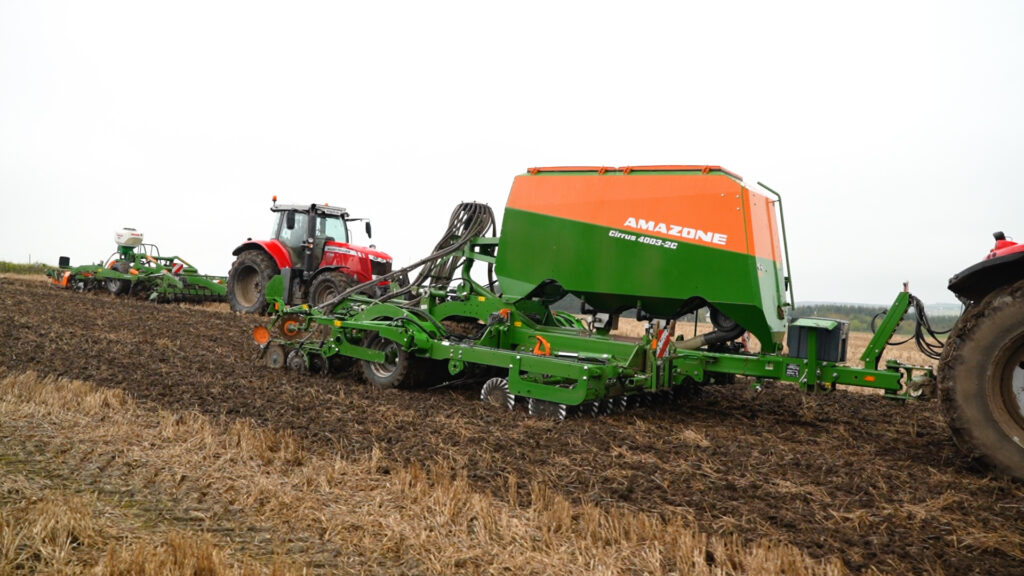Based in Aberdeenshire, Ian Partridge owns and runs, along with the family, 800 acres of mixed farming with around 550 acres dedicated to cereals and the rest put over to 200 head of cattle and 12,000 chickens. Looking to streamline his crop establishment practice and work the soil less, Ian has recently shifted away from a plough-based system and adopted a mix of both min-till and no-till techniques.
The move to an alternative establishment system was also partly driven by a change of staff and so Ian had a demonstration of an AMAZONE Cirrus trailed cultivator drill and was impressed with its build quality, the ease of maintenance and, above all, its operator-friendliness. “The conditions when we had the demonstration at the back end of the year were far from ideal, but the crops came through amazingly well and are looking quite good now”, comments Ian.
Shortly after this demonstration, Ian invested in a twin-hopper, Cirrus 4003-2C with the Minimum TillDisc system up-front. These straight-running, wavey profile discs cut a narrow slot in front of, and in line, with each coulter, allowing it to be used as well as a direct drill. ‘We can really sink the front discs in deep, especially if it’s tough going, and this enables us to form a clean, straw-free root zone for the seed’, adds Ian. In these situations, the front discs are set to depth of 4” to 5” without impacting the seeding depth which is maintained at a consistent 1” – 2” via the TwinTeC+ coulters, “This makes it easier for the root structure to develop and, as the water can drain away, it means that the seed row doesn’t sit wet”.

The possibility of being able to adjust the front disc depth from the cab was another big positive for Ian, ‘With one of our previous machines, when we added more pressure to the front discs it just lifted the whole tool carriage out of work”. Furthermore, being able to adjust the coulter pressure from the cab was an added bonus, Now, when changing between fields with different soil types, planting depth can still be maintained. When switching seed types, the seeding depth has also proved to be an easy adjustment, being a case of just going round to the rear of the drill and turning the 3 depth adjustment handles against a scale.
Ian’s previous drill combination was equipped with RoTeC pro coulters but, with the new Cirrus, the decision was made to change to the double disc, TwinTeC+ coulter. “The change to TwinTeC+ means that we are achieving a superior consistency of seeding depth, greater penetration and also better seed coverage”, Ian goes on to say. With an increase from 55 kg to 100 kg of coulter pressure along with the hard-wearing, zero maintenance discs, the benefits are fairly obvious, especially when simplicity and ease of maintenance and operation are some of the farm’s top priorities.

Regarding the calibration, Ian found the external TwinTerminal “just brilliant”. Being able to do everything from a small screen next to the metering system allows for quick calibration without the need to clamber back and forth up to the cab. In fact, states Ian, “Just about everything is done from down here, priming the metering roller, running the calibration test and then weighing it out, you never need to leave the platform. You can have everything done in minutes”.
The 60:40 split, 4,000 litre hopper on the Cirrus-2C, means that drill can handle both seed and fertiliser simultaneously with both media going down to the TwinTeC+ coulters. Upgrading up to the Cirrus-2CC adds the additional FerTeC coulters meaning that the fertiliser can be placed separately to the seed (DoubleShoot), with the seed (SingleShoot), or a mixture of both. The drill can also be equipped with the GreenDrill catch crop seeder box if required.

The investment in the Cirrus, coupled with the recent addition to the fleet of a 3 metre, AMAZONE Ceus 3000-TX trailed disc and tine cultivator, means the farm now has a streamlined approach to crop establishment; either a pass with the cultivator then followed by the drill or, for no-till, just a pass with the drill on its own.
The switch over to the AMAZONE Cirrus has resulted in a much more cost-effective method of establishment than conventional drilling systems often found in the area.

